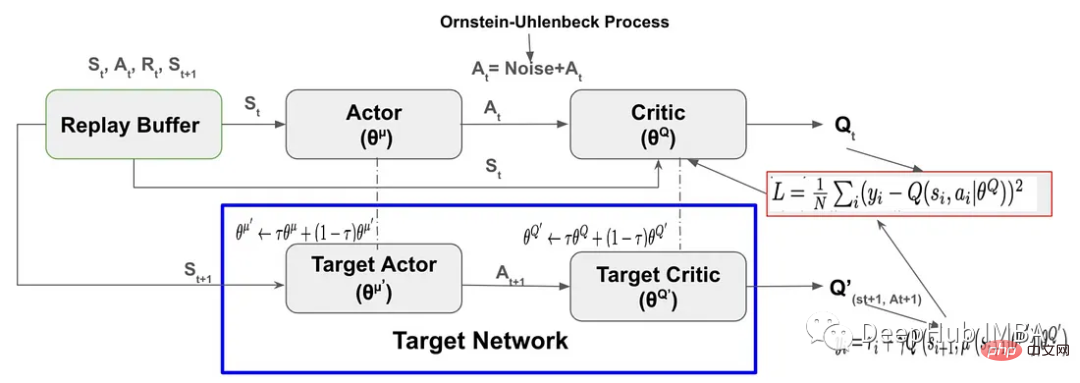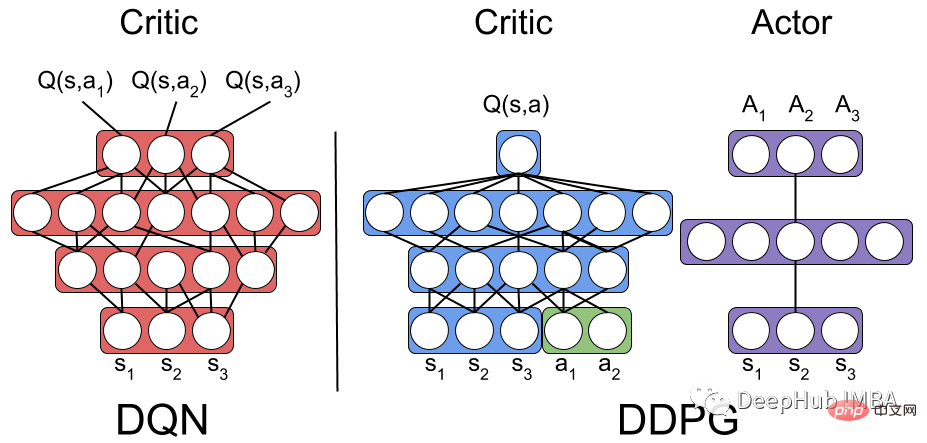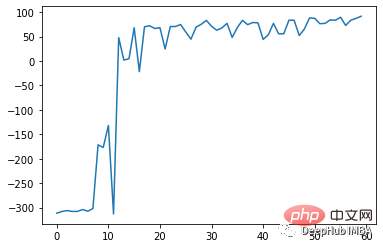ホームページ >バックエンド開発 >Python チュートリアル >PyTorch コードの実装と DDPG 強化学習の段階的な説明
PyTorch コードの実装と DDPG 強化学習の段階的な説明
- WBOYWBOYWBOYWBOYWBOYWBOYWBOYWBOYWBOYWBOYWBOYWBOYWB転載
- 2023-04-13 09:10:072075ブラウズ
Deep Deterministic Policy Gradient (DDPG) は、Deep Q-Network からインスピレーションを得た、モデルフリーの非ポリシーの深層強化アルゴリズムです。これは、ポリシー勾配を使用する Actor-Critic に基づいています。この記事では、pytorch を使用して実行します。完全実装と説明

DDPG の主要コンポーネントは
- #リプレイ バッファです
- アクター - 批評家ニューラル ネットワーク
- 探索ノイズ
- ターゲット ネットワーク
- ターゲット ネットワークのソフト ターゲットの更新
- サンプル間の相関関係を最小限に抑える: 過去の経験をリプレイ バッファーに保存することで、エージェントがさまざまな経験から学習できるようにします。経験。
- オフライン ポリシー学習を有効にする: エージェントが現在のポリシーから遷移をサンプリングする代わりに、再生バッファから遷移をサンプリングできるようにします。
- 効率的なサンプリング: 過去のエクスペリエンスをバッファーに保存し、エージェントがさまざまなエクスペリエンスから複数回学習できるようにします。
class Replay_buffer(): ''' Code based on: https://github.com/openai/baselines/blob/master/baselines/deepq/replay_buffer.py Expects tuples of (state, next_state, action, reward, done) ''' def __init__(self, max_size=capacity): """Create Replay buffer. Parameters ---------- size: int Max number of transitions to store in the buffer. When the buffer overflows the old memories are dropped. """ self.storage = [] self.max_size = max_size self.ptr = 0 def push(self, data): if len(self.storage) == self.max_size: self.storage[int(self.ptr)] = data self.ptr = (self.ptr + 1) % self.max_size else: self.storage.append(data) def sample(self, batch_size): """Sample a batch of experiences. Parameters ---------- batch_size: int How many transitions to sample. Returns ------- state: np.array batch of state or observations action: np.array batch of actions executed given a state reward: np.array rewards received as results of executing action next_state: np.array next state next state or observations seen after executing action done: np.array done[i] = 1 if executing ation[i] resulted in the end of an episode and 0 otherwise. """ ind = np.random.randint(0, len(self.storage), size=batch_size) state, next_state, action, reward, done = [], [], [], [], [] for i in ind: st, n_st, act, rew, dn = self.storage[i] state.append(np.array(st, copy=False)) next_state.append(np.array(n_st, copy=False)) action.append(np.array(act, copy=False)) reward.append(np.array(rew, copy=False)) done.append(np.array(dn, copy=False)) return np.array(state), np.array(next_state), np.array(action), np.array(reward).reshape(-1, 1), np.array(done).reshape(-1, 1)
class Actor(nn.Module): """ The Actor model takes in a state observation as input and outputs an action, which is a continuous value. It consists of four fully connected linear layers with ReLU activation functions and a final output layer selects one single optimized action for the state """ def __init__(self, n_states, action_dim, hidden1): super(Actor, self).__init__() self.net = nn.Sequential( nn.Linear(n_states, hidden1), nn.ReLU(), nn.Linear(hidden1, hidden1), nn.ReLU(), nn.Linear(hidden1, hidden1), nn.ReLU(), nn.Linear(hidden1, 1) ) def forward(self, state): return self.net(state) class Critic(nn.Module): """ The Critic model takes in both a state observation and an action as input and outputs a Q-value, which estimates the expected total reward for the current state-action pair. It consists of four linear layers with ReLU activation functions, State and action inputs are concatenated before being fed into the first linear layer. The output layer has a single output, representing the Q-value """ def __init__(self, n_states, action_dim, hidden2): super(Critic, self).__init__() self.net = nn.Sequential( nn.Linear(n_states + action_dim, hidden2), nn.ReLU(), nn.Linear(hidden2, hidden2), nn.ReLU(), nn.Linear(hidden2, hidden2), nn.ReLU(), nn.Linear(hidden2, action_dim) ) def forward(self, state, action): return self.net(torch.cat((state, action), 1))探索ノイズアクターによって選択されたアクションにノイズを追加することは、探索を促進し、学習プロセスを改善するために DDPG で使用される手法です。 ガウス ノイズまたはオーンシュタイン・ウーレンベック ノイズを使用できます。ガウス ノイズはシンプルで実装が簡単で、オーンスタイン ウーレンベック ノイズは時間相関ノイズを生成するため、エージェントがアクション スペースをより効率的に探索できるようになります。ただし、オーンシュタイン・ウーレンベック ノイズの変動は、ガウス ノイズ法よりも滑らかで、ランダム性が低くなります。
import numpy as np import random import copy class OU_Noise(object): """Ornstein-Uhlenbeck process. code from : https://math.stackexchange.com/questions/1287634/implementing-ornstein-uhlenbeck-in-matlab The OU_Noise class has four attributes size: the size of the noise vector to be generated mu: the mean of the noise, set to 0 by default theta: the rate of mean reversion, controlling how quickly the noise returns to the mean sigma: the volatility of the noise, controlling the magnitude of fluctuations """ def __init__(self, size, seed, mu=0., theta=0.15, sigma=0.2): self.mu = mu * np.ones(size) self.theta = theta self.sigma = sigma self.seed = random.seed(seed) self.reset() def reset(self): """Reset the internal state (= noise) to mean (mu).""" self.state = copy.copy(self.mu) def sample(self): """Update internal state and return it as a noise sample. This method uses the current state of the noise and generates the next sample """ dx = self.theta * (self.mu - self.state) + self.sigma * np.array([np.random.normal() for _ in range(len(self.state))]) self.state += dx return self.stateDDPG でガウス ノイズを使用するには、エージェントのアクション選択プロセスにガウス ノイズを直接追加できます。 DDPGDDPG (Deep Deterministic Policy Gradient) は、関数近似に 2 セットの Actor-Critic ニューラル ネットワークを使用します。 DDPG では、ターゲット ネットワークは Actor-Critic であり、Actor-Critic ネットワークと同じ構造とパラメータ化を持ちます。 トレーニング期間中、エージェントはアクター-クリティック ネットワークを使用して環境と対話し、経験タプル (Sₜ、Aₜ、Rₜ、Sₜ ₁) をリプレイ バッファーに保存します。次に、エージェントはリプレイ バッファからサンプリングし、そのデータで Actor-Critic ネットワークを更新します。 Actor-Critic ネットワークから直接コピーしてターゲット ネットワークの重みを更新するのではなく、DDPG アルゴリズムは、ソフト ターゲット更新と呼ばれるプロセスを通じてターゲット ネットワークの重みをゆっくりと更新します。


#Set Hyperparameters # Hyperparameters adapted for performance from capacity=1000000 batch_size=64 update_iteration=200 tau=0.001 # tau for soft updating gamma=0.99 # discount factor directory = './' hidden1=20 # hidden layer for actor hidden2=64. #hiiden laye for critic class DDPG(object): def __init__(self, state_dim, action_dim): """ Initializes the DDPG agent. Takes three arguments: state_dim which is the dimensionality of the state space, action_dim which is the dimensionality of the action space, and max_action which is the maximum value an action can take. Creates a replay buffer, an actor-critic networks and their corresponding target networks. It also initializes the optimizer for both actor and critic networks alog with counters to track the number of training iterations. """ self.replay_buffer = Replay_buffer() self.actor = Actor(state_dim, action_dim, hidden1).to(device) self.actor_target = Actor(state_dim, action_dim,hidden1).to(device) self.actor_target.load_state_dict(self.actor.state_dict()) self.actor_optimizer = optim.Adam(self.actor.parameters(), lr=3e-3) self.critic = Critic(state_dim, action_dim,hidden2).to(device) self.critic_target = Critic(state_dim, action_dim,hidden2).to(device) self.critic_target.load_state_dict(self.critic.state_dict()) self.critic_optimizer = optim.Adam(self.critic.parameters(), lr=2e-2) # learning rate self.num_critic_update_iteration = 0 self.num_actor_update_iteration = 0 self.num_training = 0 def select_action(self, state): """ takes the current state as input and returns an action to take in that state. It uses the actor network to map the state to an action. """ state = torch.FloatTensor(state.reshape(1, -1)).to(device) return self.actor(state).cpu().data.numpy().flatten() def update(self): """ updates the actor and critic networks using a batch of samples from the replay buffer. For each sample in the batch, it computes the target Q value using the target critic network and the target actor network. It then computes the current Q value using the critic network and the action taken by the actor network. It computes the critic loss as the mean squared error between the target Q value and the current Q value, and updates the critic network using gradient descent. It then computes the actor loss as the negative mean Q value using the critic network and the actor network, and updates the actor network using gradient ascent. Finally, it updates the target networks using soft updates, where a small fraction of the actor and critic network weights are transferred to their target counterparts. This process is repeated for a fixed number of iterations. """ for it in range(update_iteration): # For each Sample in replay buffer batch state, next_state, action, reward, done = self.replay_buffer.sample(batch_size) state = torch.FloatTensor(state).to(device) action = torch.FloatTensor(action).to(device) next_state = torch.FloatTensor(next_state).to(device) done = torch.FloatTensor(1-done).to(device) reward = torch.FloatTensor(reward).to(device) # Compute the target Q value target_Q = self.critic_target(next_state, self.actor_target(next_state)) target_Q = reward + (done * gamma * target_Q).detach() # Get current Q estimate current_Q = self.critic(state, action) # Compute critic loss critic_loss = F.mse_loss(current_Q, target_Q) # Optimize the critic self.critic_optimizer.zero_grad() critic_loss.backward() self.critic_optimizer.step() # Compute actor loss as the negative mean Q value using the critic network and the actor network actor_loss = -self.critic(state, self.actor(state)).mean() # Optimize the actor self.actor_optimizer.zero_grad() actor_loss.backward() self.actor_optimizer.step() """ Update the frozen target models using soft updates, where tau,a small fraction of the actor and critic network weights are transferred to their target counterparts. """ for param, target_param in zip(self.critic.parameters(), self.critic_target.parameters()): target_param.data.copy_(tau * param.data + (1 - tau) * target_param.data) for param, target_param in zip(self.actor.parameters(), self.actor_target.parameters()): target_param.data.copy_(tau * param.data + (1 - tau) * target_param.data) self.num_actor_update_iteration += 1 self.num_critic_update_iteration += 1 def save(self): """ Saves the state dictionaries of the actor and critic networks to files """ torch.save(self.actor.state_dict(), directory + 'actor.pth') torch.save(self.critic.state_dict(), directory + 'critic.pth') def load(self): """ Loads the state dictionaries of the actor and critic networks to files """ self.actor.load_state_dict(torch.load(directory + 'actor.pth')) self.critic.load_state_dict(torch.load(directory + 'critic.pth'))トレーニング DDPGここでは、OpenAI Gym の「MountainCarContinuous-v0」を使用して DDPG RL モデルをトレーニングします。ここの環境は、継続的なアクションと観察スペースを提供します。目標は、車を作ることです。できるだけ早く山の頂上に着きます。

import gym # create the environment env_name='MountainCarContinuous-v0' env = gym.make(env_name) device = 'cuda' if torch.cuda.is_available() else 'cpu' # Define different parameters for training the agent max_episode=100 max_time_steps=5000 ep_r = 0 total_step = 0 score_hist=[] # for rensering the environmnet render=True render_interval=10 # for reproducibility env.seed(0) torch.manual_seed(0) np.random.seed(0) #Environment action ans states state_dim = env.observation_space.shape[0] action_dim = env.action_space.shape[0] max_action = float(env.action_space.high[0]) min_Val = torch.tensor(1e-7).float().to(device) # Exploration Noise exploration_noise=0.1 exploration_noise=0.1 * max_action
DDPG エージェント クラスのインスタンスを作成して、指定された回数だけエージェントをトレーニングします。エージェントの update() メソッドは各ラウンドの最後に呼び出されてパラメータを更新し、save() メソッドは 10 ラウンドごとに使用され、エージェントのパラメータをファイルに保存します。
# Create a DDPG instance
agent = DDPG(state_dim, action_dim)
# Train the agent for max_episodes
for i in range(max_episode):
total_reward = 0
step =0
state = env.reset()
fort in range(max_time_steps):
action = agent.select_action(state)
# Add Gaussian noise to actions for exploration
action = (action + np.random.normal(0, 1, size=action_dim)).clip(-max_action, max_action)
#action += ou_noise.sample()
next_state, reward, done, info = env.step(action)
total_reward += reward
if render and i >= render_interval : env.render()
agent.replay_buffer.push((state, next_state, action, reward, np.float(done)))
state = next_state
if done:
break
step += 1
score_hist.append(total_reward)
total_step += step+1
print("Episode: t{} Total Reward: t{:0.2f}".format( i, total_reward))
agent.update()
if i % 10 == 0:
agent.save()
env.close()DDPG のテスト
test_iteration=100
for i in range(test_iteration):
state = env.reset()
for t in count():
action = agent.select_action(state)
next_state, reward, done, info = env.step(np.float32(action))
ep_r += reward
print(reward)
env.render()
if done:
print("reward{}".format(reward))
print("Episode t{}, the episode reward is t{:0.2f}".format(i, ep_r))
ep_r = 0
env.render()
break
state = next_stateモデルを収束させるために次のパラメーターを使用します:
- ランダム サンプリングではなく、標準正規分布からノイズをサンプリングします。
- ポリアク定数 (タウ) を 0.99 から 0.001 に変更します。
- Critic ネットワークの隠れ層サイズを [64,64] に変更します。 ReLU のアクティベーションは、Critic ネットワークの第 2 層の後に削除されます。 (線形、ReLU、線形、線形) に変更します。
- 最大バッファ サイズを 1000000 に変更します
- batch_size サイズを 128 から 64 に変更します
75 ラウンドのトレーニング後の効果は次のとおりです:

##概要
DDPG アルゴリズムは、ディープ Q ネットワーク (DQN) からインスピレーションを得た、モデルフリーのオフポリシーの Actor-Critic アルゴリズムです。アルゴリズム。ポリシー勾配法と Q ラーニングの利点を組み合わせて、継続的なアクション空間で決定論的なポリシーを学習します。
DQN と同様に、ネットワークをトレーニングするために過去の経験とターゲット ネットワークを保存するためにリプレイ バッファーを使用するため、トレーニング プロセスの安定性が向上します。
DDPG アルゴリズムでは、最適なパフォーマンスを得るために慎重なハイパーパラメーターの調整が必要です。ハイパーパラメータには、学習率、バッチ サイズ、ターゲット ネットワーク更新率、検出ノイズ パラメータが含まれます。ハイパーパラメータの小さな変更が、アルゴリズムのパフォーマンスに大きな影響を与える可能性があります。
以上がPyTorch コードの実装と DDPG 強化学習の段階的な説明の詳細内容です。詳細については、PHP 中国語 Web サイトの他の関連記事を参照してください。

